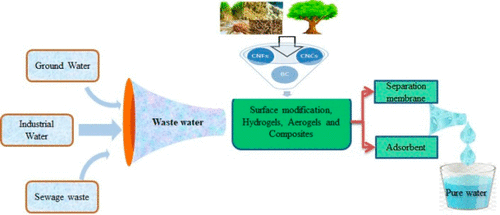当前位置:
X-MOL 学术
›
Biomacromolecules
›
论文详情
Our official English website, www.x-mol.net, welcomes your feedback! (Note: you will need to create a separate account there.)
Current State and New Trends in the Use of Cellulose Nanomaterials for Wastewater Treatment.
Biomacromolecules ( IF 6.2 ) Pub Date : 2018-08-06 , DOI: 10.1021/acs.biomac.8b00839 Ragab E Abouzeid 1, 2 , Ramzi Khiari 2, 3, 4 , Nahla El-Wakil 1 , Alain Dufresne 2
Biomacromolecules ( IF 6.2 ) Pub Date : 2018-08-06 , DOI: 10.1021/acs.biomac.8b00839 Ragab E Abouzeid 1, 2 , Ramzi Khiari 2, 3, 4 , Nahla El-Wakil 1 , Alain Dufresne 2
Affiliation

|
Nanotechnology has been identified as having great potential for improving the efficiency of water prevention and purification while reducing costs. In this field, two applications of nanocellulose have generated attention and have proven to be a sound strategy as an adsorbent and as a membrane for the removal of contaminants. This potential is attributed to its high aspect ratio, high specific surface area, high capacity retention, and environmental inertness. In addition to the aforementioned advantages, the presence of active sites allows the incorporation of chemical moieties that may enhance the binding efficiency of pollutants to the surface. This review paper intends to understand how nanocellulose affects the adsorption behavior of water pollutants, e.g., heavy metal ions, microbes, dyes, and organic molecules, and is divided in two parts. First, a general overview of the different strategies for the preparation of nanocellulose is described, and its specific properties are reported. The second section reports some of its application as adsorbent nanomaterial or separation membrane. It appears that the use of nanocellulose for these applications is very promising for wastewater treatment industries.
中文翻译:

纤维素纳米材料在废水处理中的应用现状和新趋势。
纳米技术被认为具有巨大的潜力,可以提高水的预防和净化效率,同时降低成本。在该领域中,纳米纤维素的两种应用引起了人们的注意,并已被证明是一种作为吸附剂和用于去除污染物的膜的合理策略。这种潜力归因于其高纵横比,高比表面积,高容量保持率和环境惰性。除了上述优点之外,活性位点的存在还允许引入化学部分,从而可以提高污染物与表面的结合效率。本文旨在了解纳米纤维素如何影响水污染物(例如重金属离子,微生物,染料和有机分子)的吸附行为,并分为两部分。首先,描述了制备纳米纤维素的不同策略的一般概述,并报道了其特定性质。第二部分报告了其作为吸附剂纳米材料或分离膜的一些应用。看来将纳米纤维素用于这些应用对于废水处理行业是非常有前途的。
更新日期:2018-07-18
中文翻译:

纤维素纳米材料在废水处理中的应用现状和新趋势。
纳米技术被认为具有巨大的潜力,可以提高水的预防和净化效率,同时降低成本。在该领域中,纳米纤维素的两种应用引起了人们的注意,并已被证明是一种作为吸附剂和用于去除污染物的膜的合理策略。这种潜力归因于其高纵横比,高比表面积,高容量保持率和环境惰性。除了上述优点之外,活性位点的存在还允许引入化学部分,从而可以提高污染物与表面的结合效率。本文旨在了解纳米纤维素如何影响水污染物(例如重金属离子,微生物,染料和有机分子)的吸附行为,并分为两部分。首先,描述了制备纳米纤维素的不同策略的一般概述,并报道了其特定性质。第二部分报告了其作为吸附剂纳米材料或分离膜的一些应用。看来将纳米纤维素用于这些应用对于废水处理行业是非常有前途的。



























 京公网安备 11010802027423号
京公网安备 11010802027423号